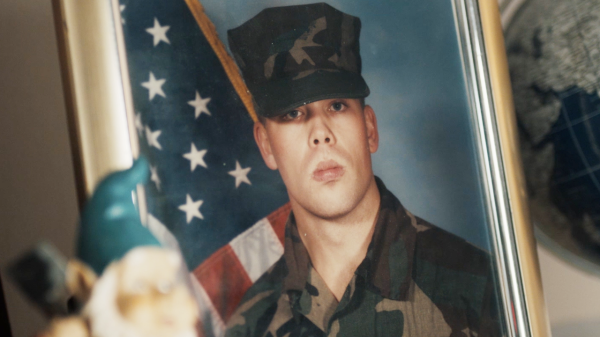
Reëntering civilian life in 2006, Richard (Mac) McKinney, a white combat veteran, brainstormed how he could protect his family and serve his country. His answer was to make a bomb.
Joshua Seftel, the director of “Stranger at the Gate,” was going to be a physician. As a young man, he planned to travel the world in the ranks of Doctors Without Borders. His father was a doctor, and, as a boy, Seftel watched him save people’s lives. During a gap year between college and applying to medical school, a professor approached him about a story in Romania. With a borrowed video camera and some fund-raising, Seftel made the film “Lost and Found,” an unflinching look at the country’s state-run orphanages. “Wow,” he thought, “filmmaking, when you do it right, can be really powerful.”
In his new documentary, Seftel brings the camera home and follows a personal drama that embodies a societal collision. The film opens on a teen-ager addressing the camera. “Most of the time when I tell people this story, they tell me that they don’t believe me,” she says. The speaker, Emily McKinney, is the stepdaughter of the man at the center of the documentary, Richard (Mac) McKinney. Emily is referring to Mac’s plan to set off an I.E.D. at a mosque, the Islamic Center of Muncie, Indiana.
The New Yorker Documentary
View the latest or submit your own film.

Mac, a white combat veteran, describes his twilight tour in the military during the early and violent years of the global war on terror, and his abrupt return to small-town Indiana, in 2006. Reëntering civilian life, he became livid, and obsessed with the local Muslim community. During the periods he describes as “between being drunk and sober,” he brainstormed how he could attack Muslims—an action he thought of as continuing to protect his family and serve his country. His answer was to make a bomb. He describes making a plan for how he could “get the most bang for my buck” by targeting his local mosque, where he hoped to injure or kill at least two hundred worshippers. When he set out on a reconnaissance mission and visited the mosque—“to get the proof” of their threat—his story took a surprising turn.
McKinney met the Bahrami family, co-founders of the center and themselves refugees of the Soviet Union’s ill-fated war in Afghanistan; and Jomo Williams, a Black local convert. The relationships were not easy ones—“These people were killers,” McKinney remembers thinking—but the members of the mosque saw that McKinney was troubled, and welcomed him.
In the film, McKinney tells his version of the transformation that ensued. Emily, her mother, Dana, members of the Bahrami family, and Williams all speak directly into the camera as well. Almost fifteen years had passed since the events they’re describing, and Seftel knew it would be a challenge to re-create the story on film. He decided to treat the camera as a microphone, relying on the spoken word rather than re-creations or other footage to give life to the past. “It was important to leave room for the viewer to imagine what happened,” he told me. “I think when you watch someone tell you a story and you look into their eyes and you watch their facial expression, you start to see the story, you start to feel the story.” Between interviews, the film uses aerial footage of the town, a visual callout to the view from a military drone. “You’re above it,” Seftel said. “You can’t quite see what’s happening, but you know it’s happening down there.”
Similarly, we see Mac, Emily, the Bahramis, and Williams making sense of a frightening and dramatic period, through the distance of time. The audience sees their faces, reconstructing a time when their paths were on a collision course—but what seemed as if it would be a violent contact became transformational. The film makes the case that enmity, even if it seems destined, can be subverted, and invites viewers, instead of trusting dogmatism, to rely on grace.
Sourse: newyorker.com






